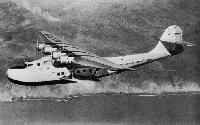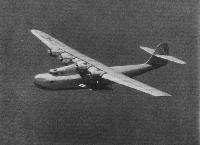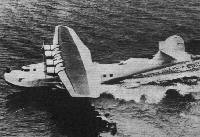
Martin China Clipper
Самолет Model 130 China Clipper, предназначенный для длительных трансокеанских перелетов, представлял собой четырехмоторный моноплан, спроектированный по схеме летающей лодки с двухреданным корпусом совершенно новой конструкции.
По экономическим критериям Model 130 превосходил DC-3, и три лодки закупила в 1935 году авиакомпания "Pan Am". Экипаж каждого гидроплана состоял из четырех человек, лодка в дневной полет могла брать на борт до 48 пассажиров. Силовая установка включала четыре мотора Pratt & Whitney R-1830 Twin Wasp мощностью по 600 л. с., установленных на передней части крыла.
<...>
Описание:
- Martin China Clipper
- Flight, January 1935
AMERICA'S LATEST "CLIPPER"
Фотографии
-
Мировая Авиация 183
Регистрационный номер: NC14714 [12], X14714 [12] В ночных полетах Model 130 China Clipper компании "Pan Am" перевозил только 78 пассажиров, для которых в салоне оборудовались спальные места.
-
Мировая Авиация 64
Регистрационный номер: NC14715 [3] 22 ноября 1935г.: компания "Pan American Airways" открыла первую регулярную почтовую авиалинию через Тихий океан полетом самолета Martin М.130 China Clipper из Сан-Франциско в Манилу, Филиппины, через Гонолулу, острова Мидуэй, Уэйк и Гуам.
-
Air International 1987-03 / R.Braybrook - The Sixties, the Thirties and the American Challenge
Регистрационный номер: NC14716 [12] In the five years leading up to World War II, the US manufacturers produced a series of flying boats for long-distance commercial operation, demonstrating a substantial lead over the rest of the world. They included the Boeing 314, the Sikorsky S-42 and Martin's M-130 (shown) "China Clipper" which, in 1934, entered service to operate a transpacific airmail service.
-
Aviation Historian 41 / D.Stringer - Around the world in 28 days!
Регистрационный номер: NC14716 [12] Three Martin M-130 Clipper-class flying-boats were built for Pan American Airways - NC14716 China Clipper (the first to be delivered, in October 1935); NC14714 Hawaii Clipper and NC14715 Philippine Clipper. Seen here is China Clipper, which completed the world’s first scheduled trans-Pacific flight in November 1935.
-
Flight 1935-08 / Flight
Регистрационный номер: X14714 [12], NC14714 [12] AMERICA'S LATEST: Recently reported as having made the 2,100 mile flight between Alameda, California, and Honolulu in 17 hr. 9 min., this Glenn Martin "Flying Clipper," which forms part of the new Pan American equipment, has cut the previous time for the journey by 50 min. The engines are Pratt and Whitney Twin "Wasps" driving constant-speed Hamilton Standard airscrews. Passenger accommodation is for about 46.
-
Flight 1935-11 / Flight
Регистрационный номер: X14714 [12], NC14714 [12] CHINA CLIPPER: This, the first of the big Martin boats to be delivered to Pan American Airways, has now been put on the experimental trans-Pacific service between Alameda (California) and the Philippines. In its "daytime" layout, the China Clipper carries forty-three passengers and cruises at 157 m.p.h. for 3,000 miles.
-
Air International 1982-03
Регистрационный номер: NC14716 [12] Pan American's "China Clipper" was one of the three Martin M-130 flying boats.
-
Air-Britain Archive 1988-04
Регистрационный номер: X14714 [12], NC14714 [12] The first Martin M130 flying boat NC14714 named "Hawaii Clipper", shown here during trials as X14714, was the subject of the Casualty Compendium accident of 28.7.38. The last of the three M130's was "China Clipper", NC14716, which survived until 8.1.45 and is the featured n the adjacent Extract dated 19.1.45.
-
Aeroplane Monthly 1996-04 / M.Roffe, D.Baker - Great moments in aviation (17)
Регистрационный номер: NC14716 [12] The first Martin 130, NC14716 China Clipper, made its maiden flight on December 20,1934, piloted by Ken Ebel. In November 1935 the aircraft made a proving flight for Hawaii Clipper’s first service from San Francisco to Manila.
-
Jane's All the World Aircraft 1980 / Encyclopedia of Aviation - 1. Chronology
Регистрационный номер: NC14716 [12] Martin M.130 China Clipper (22 November 1935).
-
Air Enthusiast 2000-03 / E.Davies - Clipper to China (1)
Регистрационный номер: NC14716 [12] 'China Clipper' NC14716 departs San Francisco Bay. The Golden Gate Bridge, still under construction, is in the background.
-
Flight 1936-04 / Flight
Регистрационный номер: NC14716 [12] An impressive flying picture of the first of the three Martin boats designed for long-distance transoceanic work - the China Clipper.
-
Flight 1935-11 / Flight
Регистрационный номер: X14714 [12], NC14714 [12] Styles from the States: The Martin 130 (four 800 h.p. Pratt and Whitney Twin Wasps). The gross weight is 51,000 lb. and maximum speed is over 170 m.p.h.
-
Flight 1935-01 / Flight
Регистрационный номер: X14714 [12], NC14714 [12] FOR THE PACIFIC? The big Martin flying boat, several of which are on order for Pan American Airways, on test near Baltimore.
On its first test flight the "Clipper" left the water in twelve seconds, flying "light." -
Flight 1936-12 / Flight
Регистрационный номер: NC14715 [3] FAR EASTERN TERMINUS: The Manila-Hongkong section of Pan-American Airways' Pacific service was covered for the first time at the end of October with Mr. Juan Trippe and nineteen passengers. In due course, Imperial Airways' Penang - Hongkong and Atlantic services will be used to carry passengers as well as mail and the Anglo-American girdle will be complete. Here is the Martin Philippine Clipper arriving at Hongkong.
-
Авиация и Время 2019-04 / А.Хаустов - ... и не только
Регистрационный номер: NC14716 [12] Летающая лодка Мартин M-130 «Китайский Клиппер». 1936 г.
-
Flight 1938-04 / Flight
Регистрационный номер: NC14716 [12] China Clipper: One of the Martin boats used for the P.A.A. trans-Pacific service.
-
Air Enthusiast 2000-03 / E.Davies - Clipper to China (1)
Departure of a Martin 130 from Alameda
-
Flight 1935-10 / Flight
Регистрационный номер: NC14716 [12] FOR THE PACIFIC SERVICE: The Martin China Clipper at Baltimore before its first passenger flight as a unit in the Pan American fleet
-
Air Enthusiast 2000-03 / E.Davies - Clipper to China (1)
Регистрационный номер: NC14714 [12], X14714 [12] Beaching gear being launched into the water, after which is its floated under the Hawaii Clipper to enable her to be brought ashore.
-
Air Enthusiast 2000-03 / E.Davies - Clipper to China (1)
Регистрационный номер: NC14716 [12] Film cameras are set up to film 'China Clipper', as she is inched down the ramp into the water. Note the well-dressed launch crew, and the large tractor on the stern line
-
Flight 1935-11 / Flight
"Seawings" is the name given to the stabilising members of the Martin. Aerodynamically they give 50 per cent of the lift of that of an aerofoil of corresponding area.
-
Air Enthusiast 2000-03 / E.Davies - Clipper to China (1)
Регистрационный номер: NC14716 [12] Unloading baggage from on of the island bases.
-
Jane's All the World Aircraft 1938 / 01 - The progress of the world in civil aviation during the year 1937-38
Регистрационный номер: NC14715 [3] TRANS-PACIFIC. - The "Philippine Clipper" of Pan American Airways arriving at Hong Kong, where the trans-Pacific service connects with Imperial Airways.
-
Flight 1934-12 / Flight
AMERICA'S NEWEST: The Martin flying boat ordered for a proposed Trans-Pacific service of Pan American Airways. Note the sponsons for lateral stability on the water, and the cowling and placing of the 800 h.p. two-row radial engines.
-
Aeroplane Monthly 1996-04 / M.Roffe, D.Baker - Great moments in aviation (17)
Регистрационный номер: X14714 [12], NC14714 [12] The third Martin 130 shortly after completion, registered X14714 and yet to be named Hawaii Clipper. Its registration was later changed to NC14714,and it was delivered to Pan American in the spring of 1936.
-
Air Enthusiast 2000-03 / E.Davies - Clipper to China (1)
Регистрационный номер: NC14714 [12], X14714 [12] PanAm's first trans-Pacific revenue passengers, prior to boarding the Hawaii Clipper for the October 22, 1936, inaugural flight. Left to right: R F Bradley, Wilbur D May, Clara Adams, Charles Bartley, Thomas Fortune Ryan, Alfred Bennett and Mrs Zetta Averill.
-
Air Enthusiast 2000-03 / E.Davies - Clipper to China (1)
Martin 130 under construction.
-
Air Enthusiast 2000-03 / E.Davies - Clipper to China (1)
Регистрационный номер: NC14714 [12], X14714 [12] Captain's instrument panel on Hawaii Clipper
-
Air Enthusiast 2000-03 / E.Davies - Clipper to China (1)
Регистрационный номер: NC14714 [12], X14714 [12] The flight engineer's station in the cabane of 'Hawaii Clipper', looking forward towards the cockpit
-
Авиация и Время 2019-04 / А.Хаустов - ... и не только
Пассажирский салон самолета M-130
-
Aeroplane Monthly 1996-04 / M.Roffe, D.Baker - Great moments in aviation (17)
Регистрационный номер: NC14714 [12], X14714 [12] Martin 130 NC14714 Hawaii Clipper arriving in the Philippines, October 1936, by Michael Roffe
-
Flight 1935-12 / Flight
TRANS-PACIFIC: This sectioned drawing of the Martin China Clipper, which is reproduced by permission of our American contemporary, Aero Digest, clearly shows its layout as a passenger carrier. The position of the main fuel tanks is interesting.
- Фотографии

































